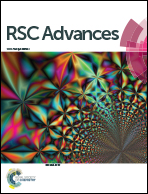Synthesis of g-C3N4 at different temperatures for superior visible/UV photocatalytic performance and photoelectrochemical sensing of MB solution†
Abstract
In this paper, a simple preparation method was utilized to study for the optimum calcination temperature of graphitic carbon nitride (g-C3N4). The g-C3N4 prepared at different temperatures were characterized by X-ray diffraction (XRD), UV-vis diffuse reflectance spectroscopy (DRS) and so on. The results demonstrated that g-C3N4 could not be formed fully until the calcination temperature was higher than 500 °C. From DRS and photoluminescence (PL) spectrum, a red shift of absorption peaks with increasing calcination temperatures was found. This could enhance the visible light absorption, and then the photocatalytic activity would be improved. The photocatalytic activity was evaluated via the photodegradation of methylene blue (MB) and 4-chlorophenol (4-CP), respectively. Moreover, due to the gradual decrement trend of photocurrent intensity with addition of MB, g-C3N4 prepared at 650 °C could be used as a photoelectrochemical sensor to detect the existence of MB and estimate the concentration of MB. Hence g-C3N4 will become a promising candidate for photoelectrochemical applications.


 Please wait while we load your content...
Please wait while we load your content...